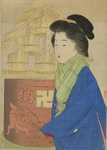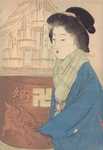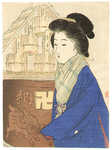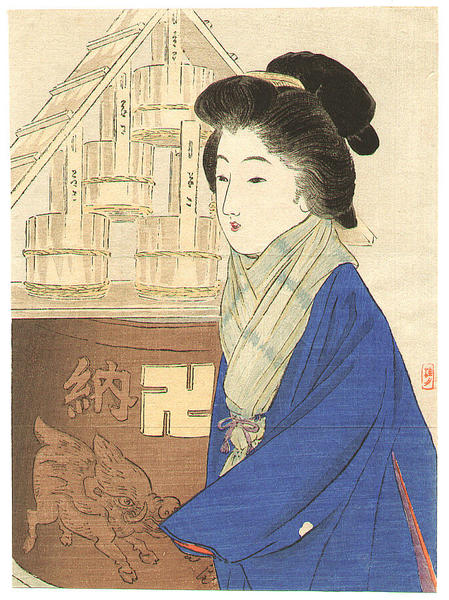| Notes (this edition)?: |
| The following information was taken from the original web listing of this artwork. Note that there may be some inaccuracies:
Saturday, 27 August 2005
Title Lady in winter
Artist Keishu Takeuchi 1861-1942
Seal keishu
Dated 1911
Publisher Bungei Kurabu
Technique/Medium Woodblock print
Impression good
Colors very good
Condition very good … slightly soiled background, two horizontal folds as usual for kuchi-e, a worm track (1/2 inch long) on the upper right background, album backing (Meiji).
Description "Marishiten" A kuchi-e (book illustration) for a story published in Bungei Kurabu, a very popular literature magazine. The backward Swastika on the background is a traditional Buddhist symbol.
Width 8.5 inches = 21.5 cm
Height 11.4 inches = 29.0 cm |
|
| Artist Bio: |
It is often claimed that the watercolour artist who signed paintings in Western script "Keishu" was the artist Takeuchi Keishu. I have yet to see any evidence that either supports or denies this claim.
Thanks to the Lavenberg Collection for the following biography:
Given name: Takeuchi Ginpei. Born in the Akasaka district in Edo, he was the second son of a retainer of the Kishu daimyo. The name Keishu was given to him by Keika-en Keika, a haiku poet and friend of his father. He received no formal education. He is primarily known as an illustrator. Keishu was adopted into the family of Kano Eitoku (1814-1891), who was head of the prestigious Nakabashi Kano lineage. But, because of the chaos in the country, there was no work for Kano1 painters so Keishu worked as a porcelain painter while studying Kano. After the suicide of his elder brother in 1879 or 1880, he returned to his father's house and abandoned the Kano style. After a disagreement about quality, Keishu switched from porcelain painting to making hanshita (drawing the black line images to be used for the keyblocks for woodblock prints.)
At some point he studied drawing under Masanobu Karino and Yoshitoshi Tsukioka (1839-1892). It is not known when Keishu began illustration. According to Keishu, his early years as a hanshita artist paid little and he was often hard-pressed for basic necessities. When his son mentioned a desire to become a painter, Keishu responded, "If you are able to live on air and water, you may become an artist."
In 1887, he joined the writing society Kenyūsha (Friends of the Inkstone - a literary coterie founded in 1885 by a group of Tokyo University students) and designed kuchi-e (woodblock-printed frontispiece illustrations produced for publication in Japanese novels and literary magazines) and sashi-e (illustrations in books, magazines, and newspapers) for the novels of many of its members including its leader Ozaki Koyo (1868-1903). He became the art editor for the Bungei Kurabu literary magazine and contributed some sixty-five kuchi-e, several of which are part of this collection.
Takeuchi was such a good friend of Ozaki Koyo that he drew the illustrations for Ozaki’s outstanding work, Konjiki Yasha (The Golden Demon), and he frequented the exclusive restaurant Koyokan in Shiba Park with the inner group members of Kenyūsha, Sazanami Iwaya, Shian Ishihashi, Bizan Kawakami (1869-1908), and Ozaki Koyo, who claimed that Koyokan was the best place to observe women. The progressive atmosphere of Koyokan, which was built in 1881 by the first president of the Yomiuri shimbun newspaper, Takashi Koyasu, perfectly matched the ethos of a group of young writers and artists, the Kenyūsha. Keishu's produced woodblocks through the Russo-Japanese War. In his later years he devoted himself to making and collecting dolls. In 1937 he was honored by the mother of Emperor Showa who requested that he paint a picture of court dolls for her.
|
|






